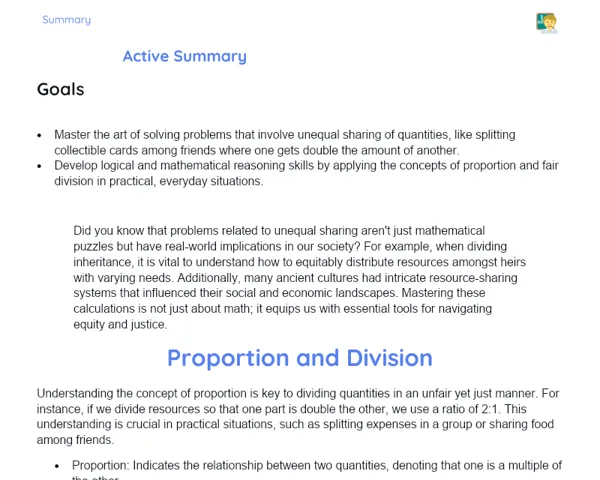Summary Tradisional | Sum of the Interior Angles of a Triangle
Contextualization
The sum of the internal angles of a triangle is a key concept in geometry, which states that no matter the type of triangle—be it equilateral, isosceles, or scalene—the sum of its internal angles is always 180 degrees. Grasping this fundamental property is vital, as it underpins many other areas in geometry and is often employed in numerous mathematical problems as well as practical scenarios.
In our daily lives, understanding the sum of the internal angles of a triangle is useful across various domains. For instance, in engineering and architecture, professionals rely on this principle to ensure accuracy and stability in their designs. Furthermore, in gaming and animation, triangle geometry is essential for crafting realistic virtual environments. Therefore, knowing this sum not only aids in solving math problems but also equips students to apply this knowledge in real-world and professional contexts.
To Remember!
Definition of Internal Angles of a Triangle
A triangle is a geometric figure with three sides and three internal angles. These angles, formed where the sides intersect, are known as internal angles. Each internal angle measures less than 180 degrees, and this sum of these angles is a significant feature of every triangle.
Depending on the type of triangle, the internal angles can differ. In an equilateral triangle, all angles are equal, each measuring 60 degrees. In an isosceles triangle, two angles are equal, while in a scalene triangle, all angles have different measures. Regardless of its type, the sum of internal angles remains constant.
Understanding what internal angles are is crucial for tackling geometric problems and applying related concepts in real-life situations. Recognizing and correctly identifying these angles is the first step in mastering work with triangles.
-
A triangle consists of three sides and three internal angles.
-
The internal angles arise from the intersection of the triangle's sides.
-
No matter the triangle, the sum of the internal angles is always 180 degrees.
Property of the Sum of Internal Angles
A key property of triangles is that their internal angles always add up to 180 degrees. This rule applies to all triangles, irrespective of their shapes and sizes. It forms a fundamental concept in Euclidean geometry and is used extensively in solving various mathematical problems.
To comprehend this property, take any triangle and measure its three internal angles. When you add these measures together, the result will invariably be 180 degrees. This constant feature of triangles is a useful tool for solving problems that include finding unknown angles.
Moreover, this property has real-world applications. Architects and engineers utilize it to ensure that the angles in their structures are precise. In gaming and animation, the accuracy of internal angles is paramount for rendering lifelike models and graphics.
-
The sum of a triangle's internal angles always totals 180 degrees.
-
This property is applicable to all triangle types.
-
It's a cornerstone characteristic of Euclidean geometry.
Visual Demonstration
A great way to visualize the sum of the internal angles of a triangle is through a simple demonstration. Draw any triangle on paper, then cut it into three parts, each holding an internal angle. Next, arrange the three angles side by side so that their points touch.
You will find that these three angles create a straight line equaling 180 degrees. This visual representation reinforces the concept that the internal angles of a triangle always sum to 180 degrees. It’s a straightforward and effective method for visualizing and understanding this aspect of geometry.
This visual approach is especially beneficial for students who grasp concepts better through visual aids. Allowing students to see and manipulate the angles physically strengthens their understanding and memory of the concept.
-
Draw and slice a triangle into three segments, each holding an angle.
-
Arrange the angles adjacent to each other to create a straight line.
-
The total angle sum is 180 degrees, illustrating the property of internal angles.
Calculating the Third Angle
Finding the third angle in a triangle when the other two are already known is a practical application of the sum of internal angles property. The basic formula to find the third angle is: Angle3 = 180° - (Angle1 + Angle2). This formula is derived from the fact that the total sum of internal angles in a triangle is always 180 degrees.
For instance, if two angles of a triangle measure 50 degrees and 60 degrees, we can find the unknown angle by deducting the sum of these angles from 180 degrees: Angle3 = 180° - (50° + 60°) = 180° - 110° = 70°. This method works for any triangle, regardless of its classification.
Practicing this calculation helps reinforce students' understanding of the sum of internal angles and builds practical skills essential for solving geometric problems. It’s a foundational skill that will come in handy across numerous mathematical and practical scenarios.
-
Use the formula: Angle3 = 180° - (Angle1 + Angle2) to derive the third angle.
-
This equation directly applies the sum of internal angles property.
-
Practicing these calculations enhances understanding and problem-solving proficiency in geometry.
Key Terms
-
Internal Angles: Angles formed by the sides of a triangle.
-
Sum of Internal Angles: The sum of the measures of the internal angles of any triangle is always 180 degrees.
-
Equilateral Triangle: A triangle where all internal angles are equal, each measuring 60 degrees.
-
Isosceles Triangle: A triangle with two equal internal angles.
-
Scalene Triangle: A triangle where all internal angles differ.
Important Conclusions
Throughout our lesson, we delved into the sum of the internal angles of a triangle, a key concept in geometry. We established that irrespective of the triangle type, the sum of its internal angles is consistently 180 degrees. This property aligns with equilateral, isosceles, and scalene triangles and is a vital aspect of Euclidean geometry.
Additionally, we looked into the practical significance of this knowledge across different fields such as engineering, architecture, and gaming design. Understanding this angle sum not only aids in solving geometric puzzles but also ensures precision in projects and constructions. We reinforced the concept through visual demonstrations and practical exercises in real-world scenarios.
In conclusion, it’s important to realize that the property of the sum of internal angles serves as a powerful tool in mathematics and its applications. We encourage students to keep exploring this topic and implement their understanding in daily or professional settings, thereby enhancing their geometric and analytical skills.
Study Tips
-
Review the solved examples in class and practice with new triangles, calculating the third angle for different angles.
-
Utilize visual tools, such as drawing and cutting triangles, to strengthen visual comprehension of the sum of internal angles.
-
Investigate real-world applications of the sum of internal angles in fields like engineering and game design, to see how this knowledge is used in actual projects.



